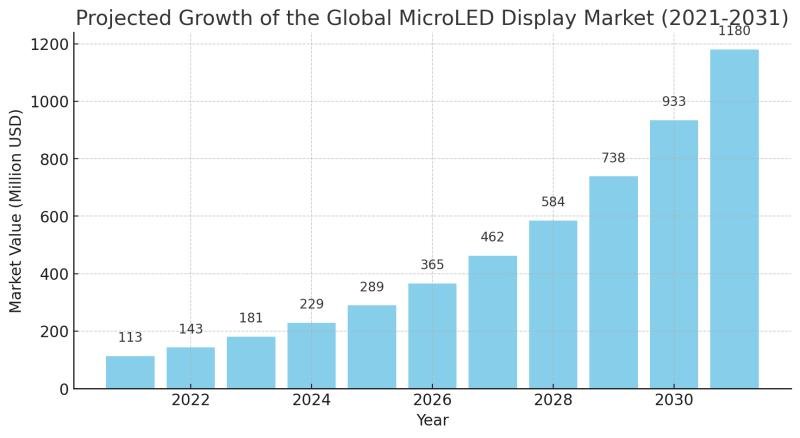The global microLED display market is on a transformative journey, driven by escalating demand for power-efficient and brilliantly bright displays across a multitude of consumer electronic applications. Valued at USD 113.4 million in 2021, the microLED display industry is projected to surge to USD 1.1 billion by 2031, advancing at a remarkable CAGR of 26.4% from 2022 through 2031. This press release provides an in-depth overview of the market, explores the latest innovations, examines key players and industry trends, and outlines regional insights and frequently asked questions.
Download now to explore primary insights from our Report in this sample – https://www.transparencymarketresearch.com/sample/sample.php?flag=S&rep_id=55566
Market Overview
MicroLED display technology is revolutionizing the way visual content is rendered on electronic devices. At the core of this innovation are microscopic light-emitting diodes (LEDs) that function as individual pixels, each capable of emitting light independently. The intrinsic characteristics of microLEDs-superior brightness, exceptional power efficiency, extended lifespan, and high contrast ratios-have positioned them as a formidable competitor to conventional display technologies such as LCD and OLED.
The burgeoning demand for microLED displays is fueled by the consumer electronics sector’s relentless drive for more efficient, vivid, and durable display solutions. This demand is further amplified by the rapid proliferation of smart wearables, augmented reality (AR) devices, digital signage, and automotive displays. Analysts believe that as microLED manufacturing processes mature, enhanced production techniques and economies of scale will pave the way for widespread adoption across diverse industries.
Market Drivers & Trends
The global microLED display market is buoyed by several key drivers and trends:
Rising Demand for Power-Efficient Displays:
With increasing energy costs and a growing emphasis on sustainability, consumers and manufacturers alike are seeking display solutions that reduce power consumption without compromising performance. MicroLED displays, with their low power requirements, meet this need effectively.
Expansion of the Consumer Electronics Sector:
The consumer electronics industry is witnessing rapid innovation, particularly in smart wearables, smartphones, tablets, and televisions. As the demand for high-resolution, bright, and durable displays rises, microLED technology is emerging as a preferred solution.
Growth in AR and VR Applications:
The development and launch of augmented reality (AR) glasses and virtual reality (VR) headsets are opening lucrative opportunities. These devices demand displays that offer high brightness, fast response times, and excellent color accuracy-all areas where microLEDs excel.
Advancements in Manufacturing Techniques:
Continued investments in R&D are leading to improvements in microLED manufacturing processes. As production becomes more cost-effective, the market is expected to overcome current pricing challenges, driving broader adoption.
Preference for MicroLEDs Over OLEDs:
Unlike OLED displays, microLEDs boast a longer lifespan and do not suffer from burn-in issues, making them a more reliable choice for long-term applications. This advantage is particularly significant in high-end consumer devices and commercial displays.
Key Players and Industry Leaders
The global microLED display market is characterized by robust competition among several prominent players who are driving innovation and expanding market share through strategic initiatives. Major industry players include:
Samsung Electronics Co., Ltd.
LG Electronics
AUO Corporation
AET Displays Limited
JBD
Micledi
Plessey
PRP Optoelectronics Ltd.
Sony Corporation
Tianma Microelectronics Co., Ltd.
These companies are at the forefront of microLED technology, investing heavily in research and development to refine manufacturing techniques and reduce production costs. Their efforts to launch advanced, scalable, and affordable microLED products are expected to catalyze market growth over the coming years.
Recent Developments
Recent developments in the microLED display market underscore the rapid pace of innovation within the industry:
September 2022: Samsung Electronics unveiled two new series of “The Wall” microLED displays in the Southeast Asia and Oceania (SEAO) region. These displays are tailored for high-end commercial applications and set new benchmarks in brightness and power efficiency.
October 2022: MICLEDI Microdisplays collaborated with Kura Technologies to develop next-generation AR glasses powered by 300mm microLED displays, heralding a new era in immersive display technologies.
January 2022: Samsung Electronics introduced its latest MICRO LED, Neo QLED, and Lifestyle TVs, further cementing its leadership in the display technology arena by offering products that combine superior image quality with energy efficiency.
These advancements not only validate the market potential but also illustrate the dynamic and competitive landscape that characterizes the microLED display industry.
Market Restraints & Challenges
Despite its promising growth trajectory, the microLED display market faces several challenges:
High Production Costs:
Currently, microLED displays are three to four times costlier than traditional OLED and LCD panels. The sophisticated manufacturing processes involved in assembling millions of individual microLEDs contribute to these higher costs.
Complex Manufacturing Techniques:
The production of microLED displays requires precision in the assembly of microscopic components, which can lead to increased defect rates and challenges in scalability.
Market Penetration Barriers:
The high initial investment required for microLED technology limits its immediate adoption, particularly in cost-sensitive markets.
Competitive Pressure:
As traditional display technologies continue to evolve, microLED manufacturers must continuously innovate to justify their higher price points and capture market share.
Supply Chain Constraints:
The availability of high-quality microLED components and the development of a robust supply chain are critical to ensuring consistent production and market expansion.
Access detailed insights by visiting our full report – https://www.transparencymarketresearch.com/micro-led-display-market.html
Market Segmentation
The microLED display market can be segmented based on product type, application, and end-use industry, providing a detailed understanding of its diverse applications:
Product Type:
Micro Display: Ideal for compact devices where high resolution and brightness are critical.
Small and Medium Size Display: Widely used in smartphones, tablets, smart wearables, and automotive head-up displays.
Large Display: Suitable for digital signage, televisions, and large-format advertising displays.
Application:
Television: Next-generation TVs that offer superior image quality and energy efficiency.
Digital Signage: High-brightness displays for commercial and public information systems.
Smartphone & Tablet: Ultra-compact displays that provide enhanced viewing experiences.
Laptop & Monitor: Devices that require high-resolution and responsive display technologies.
Smart Wearables: Wearable devices that benefit from low power consumption and vibrant displays.
Others: Including optical devices and AR glasses that demand innovative display solutions.
End-use Industry:
Consumer Electronics: The largest segment driven by smartphones, TVs, and wearable devices.
Automotive: Advanced head-up displays and in-car entertainment systems.
Retail: Digital signage and interactive display solutions.
Healthcare: High-performance displays for medical imaging and diagnostics.
Government: Public information displays and secure communication systems.
Aerospace & Defense: Specialized displays that require high durability and reliability.
Others: Including hospitality, media & entertainment, and more.
Market Growth Factors
Several factors are expected to contribute to the robust growth of the microLED display market:
Technological Superiority: MicroLED displays offer a compelling blend of high brightness, power efficiency, and durability that meets the evolving demands of modern consumer electronics.
Consumer Demand: The increasing preference for high-quality displays in everyday devices-from smartphones to large digital signage-drives market expansion.
Innovation in AR/VR: The burgeoning AR and VR markets require displays that can deliver immersive experiences with high resolution and minimal latency.
Enhanced Manufacturing Processes: Ongoing R&D investments aimed at reducing production costs and improving yield rates are expected to mitigate current manufacturing challenges.
Energy Efficiency Requirements: The global push for energy conservation and sustainable technologies supports the adoption of low-power microLED displays.
Regional Insights
The global microLED display market is witnessing dynamic regional trends:
North America: Expected to be a leading market due to its strong consumer electronics base and high adoption rate of advanced display technologies. North America accounted for a 32.0% share in 2021, driven by a robust ecosystem of technological innovation and high consumer spending on premium devices.
Asia Pacific: Poised to grow at the fastest rate during the forecast period, Asia Pacific benefits from significant investments in R&D, manufacturing capabilities, and a large consumer market. The region is rapidly emerging as a hub for both production and consumption of next-generation display technologies.
Europe: With strong industrial and consumer segments, Europe is seeing increased adoption of microLED displays in automotive, digital signage, and smart devices. Stringent environmental regulations and energy efficiency mandates further fuel the transition toward advanced display solutions.
Other Regions: Markets in South America, the Middle East & Africa are gradually embracing microLED technology as global supply chains expand and production costs decline, enabling broader adoption in emerging markets.
Buy this Premium Research Report and access vital insights and analysis – https://www.transparencymarketresearch.com/checkout.php?rep_id=55566<ype=S
Frequently Asked Questions
What is the projected market value of the global microLED display market by 2031?
The market is expected to reach US$ 1.1 billion by 2031.
What factors are driving the growth of the microLED display market?
Key drivers include the demand for power-efficient and bright displays, the expansion of the consumer electronics sector, increased adoption of AR/VR devices, and technological advancements that enhance display performance and durability.
How do microLED displays compare to OLED and LCD technologies?
MicroLED displays offer superior brightness, higher energy efficiency, longer lifespans, and reduced issues with burn-in compared to OLEDs, while also providing better contrast and lower power consumption than LCDs.
Which regions are leading the market, and why?
North America currently leads the market due to high consumer spending and technological innovation, while Asia Pacific is expected to grow the fastest, driven by significant investments in manufacturing and R&D.
What are the main challenges facing the microLED display market?
Major challenges include high production costs, complex manufacturing processes, and competitive pressure from established display technologies.
Which industries are the primary end-users of microLED displays?
Primary end-use industries include consumer electronics, automotive, digital signage, healthcare, government, and aerospace & defense.
Explore Latest Research Reports by Transparency Market Research:
Motor Driver ICs Market: https://www.transparencymarketresearch.com/motor-driver-ics-market.html
5G Smart Antenna Market: https://www.transparencymarketresearch.com/5g-smart-antenna-market.html
About Transparency Market Research
Transparency Market Research, a global market research company registered at Wilmington, Delaware, United States, provides custom research and consulting services. Our exclusive blend of quantitative forecasting and trends analysis provides forward-looking insights for thousands of decision makers. Our experienced team of Analysts, Researchers, and Consultants use proprietary data sources and various tools & techniques to gather and analyses information.
Our data repository is continuously updated and revised by a team of research experts, so that it always reflects the latest trends and information. With a broad research and analysis capability, Transparency Market Research employs rigorous primary and secondary research techniques in developing distinctive data sets and research material for business reports.
Contact:
Transparency Market Research Inc.
CORPORATE HEADQUARTER DOWNTOWN,
1000 N. West Street,
Suite 1200, Wilmington, Delaware 19801 USA
Tel: +1-518-618-1030
USA – Canada Toll Free: 866-552-3453
Website: https://www.transparencymarketresearch.com
Email: sales@transparencymarketresearch.com
Follow Us: LinkedIn| Twitter| Blog | YouTube
This release was published on openPR.



















